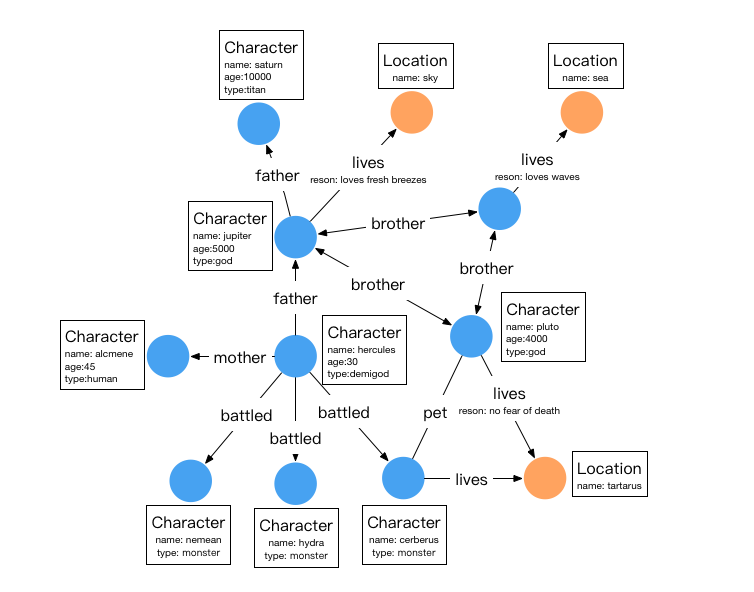HugeGraph Examples
1 概述
本示例将TitanDB Getting Started 为模板来演示 HugeGraph 的使用方法。通过对比 HugeGraph 和 TitanDB,了解 HugeGraph 和 TitanDB 的差异。
1.1 HugeGraph 与 TitanDB 的异同
HugeGraph 和 TitanDB 都是基于Apache TinkerPop3框架的图数据库,均支持Gremlin图查询语言,在使用方法和接口方面具有很多相似的地方。然而 HugeGraph 是全新设计开发的,其代码结构清晰,功能较为丰富,接口更为友好等特点。
HugeGraph 相对于 TitanDB 而言,其主要特点如下:
- HugeGraph 目前有 HugeGraph-API、HugeGraph-Client、HugeGraph-Loader、HugeGraph-Studio、HugeGraph-Spark 等完善的工具组件,可以完成系统集成、数据载入、图可视化查询、Spark 连接等功能;
- HugeGraph 具有 Server 和 Client 的概念,第三方系统可以通过 jar 引用、client、api 等多种方式接入,而 TitanDB 仅支持 jar 引用方式接入。
- HugeGraph 的 Schema 需要显式定义,所有的插入和查询均需要通过严格的 schema 校验,目前暂不支持 schema 的隐式创建。
- HugeGraph 充分利用后端存储系统的特点来实现数据高效存取,而 TitanDB 以统一的 Kv 结构无视后端的差异性。
- HugeGraph 的更新操作可以实现按需操作(例如:更新某个属性)性能更好。TitanDB 的更新是 read and update 方式。
- HugeGraph 的 VertexId 和 EdgeId 均支持拼接,可实现自动去重,同时查询性能更好。TitanDB 的所有 Id 均是自动生成,查询需要经索引。
1.2 人物关系图谱
本示例通过 Property Graph Model 图数据模型来描述希腊神话中各人物角色的关系(也被成为人物关系图谱),具体关系详见下图。

其中,圆形节点代表实体 (Vertex),箭头代表关系(Edge),方框的内容为属性。
该关系图谱中有两类顶点,分别是人物(character)和位置(location)如下表:
| 名称 | 类型 | 属性 |
|---|---|---|
| character | vertex | name,age,type |
| location | vertex | name |
有六种关系,分别是父子(father)、母子(mother)、兄弟(brother)、战斗(battled)、居住 (lives)、拥有宠物(pet)关于关系图谱的具体信息如下:
| 名称 | 类型 | source vertex label | target vertex label | 属性 |
|---|---|---|---|---|
| father | edge | character | character | - |
| mother | edge | character | character | - |
| brother | edge | character | character | - |
| pet | edge | character | character | - |
| lives | edge | character | location | reason |
在 HugeGraph 中,每个 edge label 只能作用于一对 source vertex label 和 target vertex label。也就是说,如果一个图内定义了一种关系 father 连接 character 和 character,那 farther 就不能再连接其他的 vertex labels。
因此本例子将原TitanDB中的monster, god, human, demigod均使用相同的vertex label: character来表示, 同时增加属性type来标识人物的类型。edge label与原TitanDB保持一致。当然为了满足edge label约束,也可以通过调整edge label的name来实现。
2 Graph Schema and Data Ingest Examples
HugeGraph 需要显示创建 Schema,因此需要依次创建 PropertyKey、VertexLabel、EdgeLabel,如果有需要索引还需要创建 IndexLabel。
2.1 Graph Schema
schema = hugegraph.schema()
schema.propertyKey("name").asText().ifNotExist().create()
schema.propertyKey("age").asInt().ifNotExist().create()
schema.propertyKey("time").asInt().ifNotExist().create()
schema.propertyKey("reason").asText().ifNotExist().create()
schema.propertyKey("type").asText().ifNotExist().create()
schema.vertexLabel("character").properties("name", "age", "type").primaryKeys("name").nullableKeys("age").ifNotExist().create()
schema.vertexLabel("location").properties("name").primaryKeys("name").ifNotExist().create()
schema.edgeLabel("father").link("character", "character").ifNotExist().create()
schema.edgeLabel("mother").link("character", "character").ifNotExist().create()
schema.edgeLabel("battled").link("character", "character").properties("time").ifNotExist().create()
schema.edgeLabel("lives").link("character", "location").properties("reason").nullableKeys("reason").ifNotExist().create()
schema.edgeLabel("pet").link("character", "character").ifNotExist().create()
schema.edgeLabel("brother").link("character", "character").ifNotExist().create()
2.2 Graph Data
// add vertices
Vertex saturn = graph.addVertex(T.label, "character", "name", "saturn", "age", 10000, "type", "titan")
Vertex sky = graph.addVertex(T.label, "location", "name", "sky")
Vertex sea = graph.addVertex(T.label, "location", "name", "sea")
Vertex jupiter = graph.addVertex(T.label, "character", "name", "jupiter", "age", 5000, "type", "god")
Vertex neptune = graph.addVertex(T.label, "character", "name", "neptune", "age", 4500, "type", "god")
Vertex hercules = graph.addVertex(T.label, "character", "name", "hercules", "age", 30, "type", "demigod")
Vertex alcmene = graph.addVertex(T.label, "character", "name", "alcmene", "age", 45, "type", "human")
Vertex pluto = graph.addVertex(T.label, "character", "name", "pluto", "age", 4000, "type", "god")
Vertex nemean = graph.addVertex(T.label, "character", "name", "nemean", "type", "monster")
Vertex hydra = graph.addVertex(T.label, "character", "name", "hydra", "type", "monster")
Vertex cerberus = graph.addVertex(T.label, "character", "name", "cerberus", "type", "monster")
Vertex tartarus = graph.addVertex(T.label, "location", "name", "tartarus")
// add edges
jupiter.addEdge("father", saturn)
jupiter.addEdge("lives", sky, "reason", "loves fresh breezes")
jupiter.addEdge("brother", neptune)
jupiter.addEdge("brother", pluto)
neptune.addEdge("lives", sea, "reason", "loves waves")
neptune.addEdge("brother", jupiter)
neptune.addEdge("brother", pluto)
hercules.addEdge("father", jupiter)
hercules.addEdge("mother", alcmene)
hercules.addEdge("battled", nemean, "time", 1)
hercules.addEdge("battled", hydra, "time", 2)
hercules.addEdge("battled", cerberus, "time", 12)
pluto.addEdge("brother", jupiter)
pluto.addEdge("brother", neptune)
pluto.addEdge("lives", tartarus, "reason", "no fear of death")
pluto.addEdge("pet", cerberus)
cerberus.addEdge("lives", tartarus)
2.3 Indices
HugeGraph 默认是自动生成 Id,如果用户通过primaryKeys指定VertexLabel的primaryKeys字段列表后,VertexLabel的 Id 策略将会自动切换到primaryKeys策略。启用primaryKeys策略后,HugeGraph 通过vertexLabel+primaryKeys拼接生成VertexId ,可实现自动去重,同时无需额外创建索引即可以使用primaryKeys中的属性进行快速查询。例如 “character” 和 “location” 都有primaryKeys("name")属性,因此在不额外创建索引的情况下可以通过g.V().hasLabel('character') .has('name','hercules')查询 vertex。
3 Graph Traversal Examples
3.1 Traversal Query
1. Find the grandfather of hercules
g.V().hasLabel('character').has('name','hercules').out('father').out('father')
也可以通过repeat方式:
g.V().hasLabel('character').has('name','hercules').repeat(__.out('father')).times(2)
2. Find the name of Hercules’s father
g.V().hasLabel('character').has('name','hercules').out('father').value('name')
3. Find the characters with age > 100
g.V().hasLabel('character').has('age',gt(100))
4. Find who are pluto’s cohabitants
g.V().hasLabel('character').has('name','pluto').out('lives').in('lives').values('name')
5. Find pluto can’t be his own cohabitant
pluto = g.V().hasLabel('character').has('name', 'pluto')
g.V(pluto).out('lives').in('lives').where(is(neq(pluto)).values('name')
// use 'as'
g.V().hasLabel('character').has('name', 'pluto').as('x').out('lives').in('lives').where(neq('x')).values('name')
6. Pluto’s Brothers
pluto = g.V().hasLabel('character').has('name', 'pluto').next()
// where do pluto's brothers live?
g.V(pluto).out('brother').out('lives').values('name')
// which brother lives in which place?
g.V(pluto).out('brother').as('god').out('lives').as('place').select('god','place')
// what is the name of the brother and the name of the place?
g.V(pluto).out('brother').as('god').out('lives').as('place').select('god','place').by('name')
推荐使用HugeGraph-Hubble 通过可视化的方式来执行上述代码。另外也可以通过 HugeGraph-Client、HugeApi、GremlinConsole 和 GremlinDriver 等多种方式执行上述代码。
3.2 总结
HugeGraph 目前支持 Gremlin 的语法,用户可以通过 Gremlin / REST-API 实现各种查询需求。